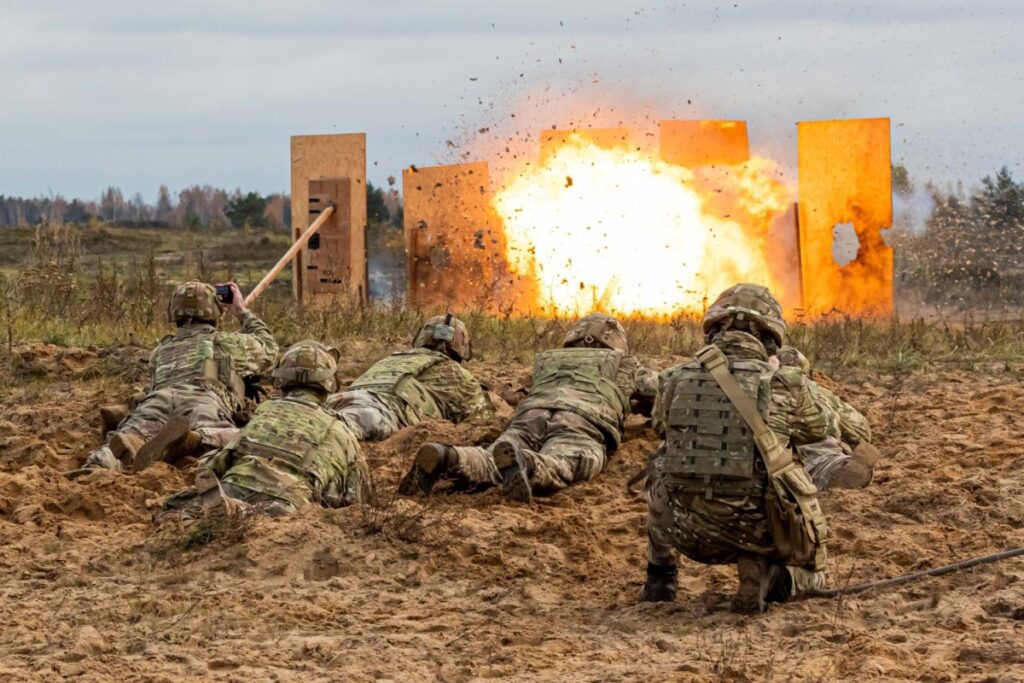U.S. Army Soldiers with 9th Brigade Engineer Battalion, 2nd Armored Brigade Combat Team, 3rd Infantry Division, joined other multinational troops for exercise Verboom in Adazi, Latvia, Oct. 28, 2023. During exercise Verboom, U.S. engineers supported helped construct an improvised door handle charge to demonstrate how to infiltrate a locked door. (U.S. Army photo by Capt. H Howey)
Maine’s congressional delegation signed a bipartisan letter requesting a review of federal efforts to identify, prevent and treat traumatic brain injuries related to military blasts, which had likely been the case for the perpetrator of the Lewiston mass shooting.
Earlier this spring, Boston University researchers found significant evidence that mass shooter Robert R. Card II had traumatic brain injuries when he killed 18 people and injured 13 others in October. The post-mortem study of Card’s brain, released with the permission of Card’s family “in an effort to prevent future tragedies,” found he likely experienced traumatic brain injuries through repeated exposure to explosive blast waves over the course of his military career. Card was an instructor at an Army hand grenade training range, where he was likely exposed to thousands of low-level blasts.
The bipartisan letter signed by the Maine delegation, U.S. Sens. Susan Collins and Angus King and Reps. Jared Golden and Chellie Pingree, along with 20 other members of Congress on May 29, asks the U.S. Government Accountability Office to review the Department of Defense’s research on traumatic brain injuries linked to military blasts as well its efforts to identify those most at-risk for blast overpressure, which occurs when the pressure from a shock wave exceeds normal atmospheric values, leading to brain damage due to movement inside the skull.
The post-mortem study of Card’s brain aligned with previous studies on the effects of blast injury in humans and experimental models, according to Anne McKee, director of Boston University’s CTE Center. “While I cannot say with certainty that these pathological findings underlie Mr. Card’s behavioral changes in the last 10 months of life,” McKee said, “based on our previous work, brain injury likely played a role in his symptoms.”
The issue extends well beyond Card. In 2020, the Department of Defense provided treatment for traumatic brain injuries over 210,000 times. The letter also cites a New York Times investigation from the fall, which found troops who had bombarded the Islamic State with large numbers of artillery rounds in 2016 and 2017 had nightmares, hallucinations, panic attacks and suicidal ideation, among other symptoms.
Further, the reporting concluded that firing a high number of rounds “could result in the artillery community suffering injuries faster than combat replacements can be trained to replace them.”
The letter comes after a February meeting of the Senate Armed Services Personnel Subcommittee, during which lawmakers raised concerns about uncertainty over the department’s strategy to address the problem. The Department of Defense has spent nearly $3 billion on traumatic brain injury research since the 2020 fiscal year, according to the members of Congress, however “major gaps remain in turning this research into action to better protect service members’ brain health.”
The department is expecting results from an analysis and lessons learned on blast monitoring to be completed in September, but the lawmakers urged more immediate action in their letter, also calling for a reassessment of the department’s list of most at-risk military occupational specialties to blast exposure and better protections from retaliation for service members seeking care for blast-related injuries.
SUPPORT NEWS YOU TRUST.
The post Congress calls for review of injuries from military blasts in light of Lewiston shooter history appeared first on Maine Morning Star.

